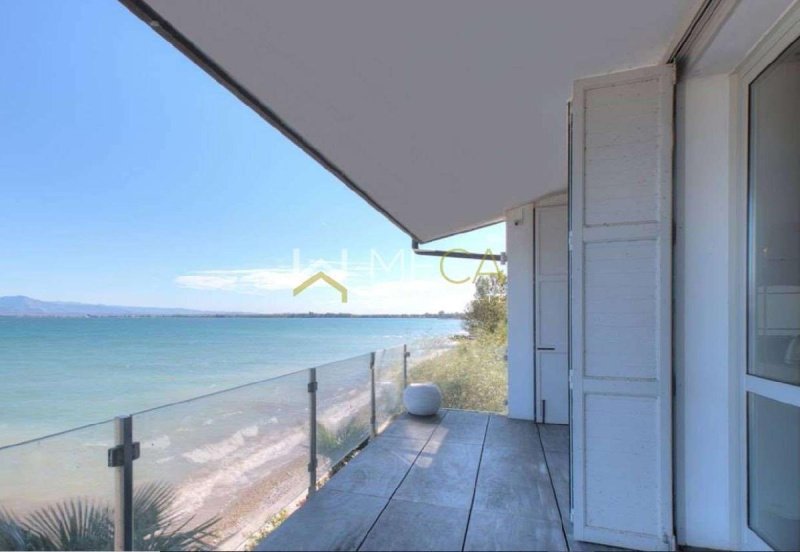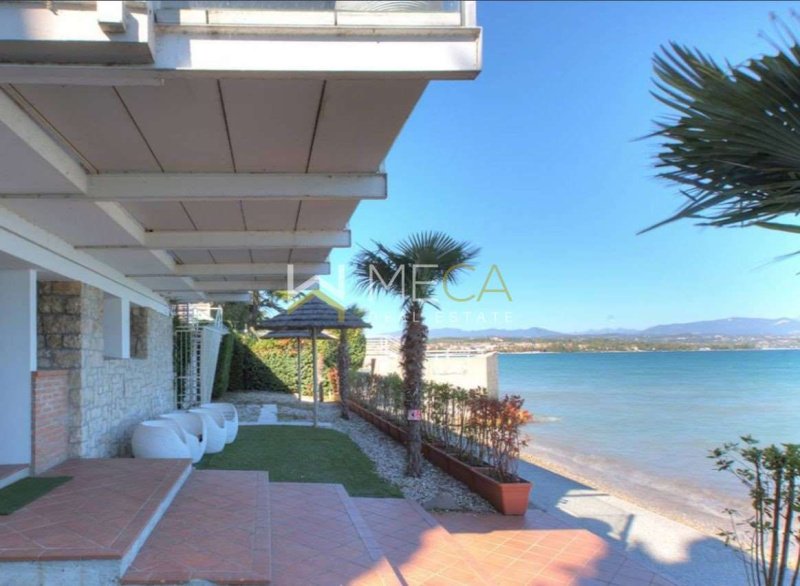Desenzano del Garda, lakefront villa a short distance from the center and the lakefront, renovated in 2017, with terrace, private garden, garage and private beach with state concession.
The villa measures 200 square meters, spread over two levels connected by a lift, which also connects the garage; upper floor with kitchen, dining room and living room with access to a large terrace, bathroom and two bedrooms;
lower floor with tavern and access to private beach, kitchen, further bathroom and study or guest room.
The property includes a private garden of approximately 200 square meters and a garage of approximately 30 square meters.
Exceptional location in the heart of Desenzano, lake view and proximity to the lakefront and public and commercial services.
Lake Garda
Lake Garda or Benaco is the largest Italian lake, with an area of about 370 km² (third by depth after Como and Maggiore). A hinge between three regions, Lombardy (province of Brescia), Veneto (province of Verona), Trentino-Alto Adige (province of Trento), it is placed in parallel with the Adige, from which it is divided by the Monte Baldo massif. To the north it is narrow and funnel-shaped while to the south it widens, surrounded by moraine hills that make the landscape sweeter. The lake is an important tourist destination and is visited by millions of people every year. In Roman times the lake was known as Benacus and by some it was revered as god Benacus, the very personification of the lake, sometimes associated with the cult of the god Neptune. Today it is better known as Lake Garda, a toponym attested since the Middle Ages and of Germanic origin, deriving from that of the homonymous town on the Veronese shore of the lake, which, together with another famous locality of the lake, Gardone Riviera, and others less known, such as Gàrdola, Gardoncino, Gardoni, Guàrdola and Le Garde, testifies to the Germanic presence that goes from the sixth to the eighth century, in particular the Lombard one. The toponym Garda, with which the lake is already called in some documents of the eighth century, is the evolution of the Germanic word warda; or guard place or place of observation. The classic toponym of the lake, or Bencus lacus (Benaco), is almost certainly of Celtic origin, thus preceding the Roman dominion, and should derive from bennacus, comparable with the Irish bennach, and would mean horned, or from the many promontories. The translation horned is also interpreted in reference to the Sirmione peninsula. The Latin voice of Benaco is attested as Bencus, -i and therefore presupposes a flat accent (Benàco): the Italian version of the tonic accent remains faithful to the Latin accent, so it must be pronounced with the accent on a. The inhabitants of the lake, especially those of the Veronese shore, pronounce the name Benaco with the accent on the e, or Bènaco. It remains unclear why the natives of the lake areas tend to use the version with the slippery accent of the name.
自动翻译所用的语言
Desenzano del Garda, villa fronte lago a breve distanza dal centro e dal lungolago, ristrutturata nel 2017, con terrazza, giardino privato, garage e spiaggia privata con concessione demaniale.
La villa misura 200 metri quadrati calpestabili, si sviluppa su due livelli collegati da ascensore, il quale collega anche il garage; piano superiore con cucina abitabile, sala da pranzo e soggiorno con accesso a terrazza abitabile, bagno e due camere;
piano inferiore con taverna e accesso a spiaggia privata, cucina, ulteriore bagno e studio oppure camera per gli ospiti.
La proprietà include un giardino privato di circa 200 metri quadrati e un garage di circa 30 metri quadrati.
Posizione eccezionale nel pieno centro di Desenzano, vista lago e vicinanza al lungolago ed ai servizi pubblici e commerciali.
Il lago di Garda
Il lago di Garda o Benaco è il maggiore lago italiano, con una superficie di circa 370 km² (terzo per profondità dopo Como e Maggiore). Cerniera fra tre regioni, Lombardia (provincia di Brescia), Veneto (provincia di Verona), Trentino-Alto Adige (provincia di Trento), è posto in parallelo all'Adige, da cui è diviso dal massiccio del monte Baldo. A settentrione si presenta stretto a imbuto mentre a meridione si allarga, circondato da colline moreniche che rendono più dolce il paesaggio. Il lago è un'importante meta turistica ed è visitato ogni anno da milioni di persone. In epoca romana il lago era conosciuto come Benacus e da alcuni era venerato come dio Benacus, personificazione stessa del lago, talvolta associata al culto del dio Nettuno. Oggi è meglio noto come lago di Garda, toponimo attestato fin dal Medioevo e di origine germanica, derivante da quello dell'omonima cittadina sulla sponda veronese del lago, la quale, insieme a un'altra località celebre del lago, Gardone Riviera, e altre meno conosciute, come Gàrdola, Gardoncino, Gardoni, Guàrdola e Le Garde, testimonia la presenza germanica che va dal VI all'VIII secolo, in particolare quella longobarda. Il toponimo Garda, con il quale è chiamato il lago già in alcuni documenti dell'VIII secolo, è l'evoluzione della voce germanica warda, ovvero luogo di guardia o luogo di osservazione. Il toponimo classico del lago, ovvero Bencus lacus (Benaco), è quasi sicuramente di origine celtica, precedente quindi al dominio romano, e dovrebbe derivare da bennacus, confrontabile con l'irlandese bennach, e significherebbe cornuto, ovvero dai molti promontori. La traduzione cornuto viene anche interpretata in riferimento alla penisola di Sirmione. La voce latina di Benaco è attestata come Bencus, -i e presuppone quindi un accento piano (Benàco): la versione italiana dell'accento tonico rimane fedele all'accentazione latina, quindi va pronunciato con l'accento sulla a. Gli abitanti del lago, in particolar modo quelli della sponda veronese, pronunciano il nome Benaco con l'accento sulla e, ovvero Bènaco. Resta oscuro il motivo per cui i nativi delle zone del lago tendono ad utilizzare la versione con l'accento sdrucciolo del nome.
CLASSE ENERGETICA: In fase di valutazione
Desenzano del Garda, Villa am See, nicht weit vom Zentrum und der Seepromenade entfernt, renoviert im Jahr 2017, mit Terrasse, privatem Garten, Garage und privatem Strand mit staatlicher Konzession.
Die Villa misst 200 Quadratmeter, verteilt auf zwei Ebenen, die durch einen Aufzug verbunden sind, der auch die Garage verbindet; Obergeschoss mit Küche, Esszimmer und Wohnzimmer mit Zugang zu einer großen Terrasse, Bad und zwei Schlafzimmern;
untere Etage mit Taverne und Zugang zum Privatstrand, Küche, weiteres Badezimmer und Arbeits- oder Gästezimmer.
Das Anwesen umfasst einen privaten Garten von etwa 200 Quadratmetern und eine Garage von etwa 30 Quadratmetern.
Außergewöhnliche Lage im Herzen von Desenzano, Seeblick und Nähe zum Seeufer sowie zu öffentlichen und kommerziellen Dienstleistungen.
Gardasee
Der Gardasee oder Benaco ist der größte italienische See mit einer Fläche von etwa 370 km² (drittgrößter nach Como und Maggiore). Als Scharnier zwischen drei Regionen, Lombardei (Provinz Brescia), Venetien (Provinz Verona), Trentino-Südtirol (Provinz Trient), liegt es parallel zur Etsch, von der es durch das Massiv des Monte Baldo getrennt wird. Im Norden ist es schmal und trichterförmig, während es sich im Süden erweitert, umgeben von Moränenhügeln, die die Landschaft süßer machen. Der See ist ein wichtiges Touristenziel und wird jedes Jahr von Millionen von Menschen besucht. In der Römerzeit war der See als Benacus bekannt und von einigen wurde er als Gott Benacus verehrt, die eigentliche Personifikation des Sees, der manchmal mit dem Kult des Gottes Neptun in Verbindung gebracht wird. Heute ist er besser bekannt als Gardasee, ein seit dem Mittelalter bezeugter Ortsname germanischen Ursprungs, der von dem gleichnamigen Ort am Veroneser Ufer des Sees abstammt, der zusammen mit einem anderen berühmten Ort des Sees, Gardone Riviera, und weniger bekannte wie Gàrdola, Gardoncino, Gardoni, Guàrdola und Le Garde zeugen von der germanischen Präsenz, die vom sechsten bis zum achten Jahrhundert reicht, insbesondere der lombardischen. Der Ortsname Garda, mit dem der See bereits in einigen Dokumenten des achten Jahrhunderts bezeichnet wird, ist die Weiterentwicklung des germanischen Wortes warda, oder Wachort oder Beobachtungsort. Der klassische Ortsname des Sees, oder Bencus lacus (Benaco), ist mit ziemlicher Sicherheit keltischen Ursprungs, geht also der römischen Herrschaft voraus und dürfte sich von bennacus ableiten, vergleichbar mit dem irischen bennach, und würde gehörnt oder von den vielen bedeuten Vorgebirge. Die Übersetzung gehörnt wird auch in Bezug auf die Halbinsel Sirmione interpretiert. Die lateinische Stimme von Benaco ist als Bencus, -i bezeugt und setzt daher einen flachen Akzent (Benàco) voraus: Die italienische Version des Tonika-Akzents bleibt dem lateinischen Akzent treu, muss also mit dem Akzent auf a ausgesprochen werden. Die Bewohner des Sees, insbesondere die der veronesischen Küste, sprechen den Namen Benaco mit Betonung auf dem e oder Bènaco aus. Unklar bleibt, warum die Eingeborenen der Seengebiete dazu neigen, die Version mit dem schlüpfrigen Akzent des Namens zu verwenden.


